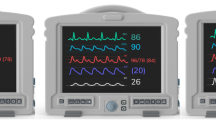Abstract
Disordered cerebral autoregulation during cardiopulmonary bypass (CPB) is regarded as one of the causes of neurological dysfunction after cardiac surgery. However, little documentation of risk factors associated with cerebral autoregulation during CPB has been reported. Sixty consecutive patients undergoing coronary artery bypass were classified into subgroups according to whether they had preoperative cerebrovascular disease (CVD), hypertension (HT), or diabetes (DM). Cerebral oxygenation was monitored by jugular venous bulb oxygen saturation (SjvO2) and near-infrared spectroscopy parameter (%Oxy-Hb) during the operation, and the relationships between these values and intraoperative parameters were evaluated. The results showed that SjvO2 and %Oxy-Hb in the CVD+group were lower than in the CVD-group. Multiple stepwise regression analysis on SjvO2 and %Oxy-Hb in the CVD+ group revealed that only MAP was a predictive factor and that there was a positive correlation between MAP and both SjvO2 and %Oxy-Hb (r=.651,r=.693, respectively,P<0.0001). The coexistence of HT and DM increased the strength of the correlation between MAP and SjvO2 (r=.863,p<0.0001) PaCO2 was the predictive factor in the CVD- group. A positive correlation was found with SjvO2 (r=.458,P>0.0001), and the correlation was stronger in patients without any risk factors (r=.671,P=0.0001). The results suggested that patients with CVD, HT, and DM may experience failure of cerebral pressureflow autoregulation and cerebrovascular reactivity during CPB.
Similar content being viewed by others
References
Shell RM, Kern FH, Greeley WJ, Schulman SR, Frasco PE, Croughwell ND, Newman N, Reves JG. Cerebral blood flow and metabolism during cardiopulmonary bypass. Anesth Analg 1993;76:849–865
Strandgaard S, Paulson OB. Cerebral autoregulation. Stroke 1984;15:413–416
Patel RL, Turtle MR, Chambers DJ, James DN, Newman S, Venn GE. α-Stat acid base regulation during cardiopulmonary bypass improves neuropsychologic outcome in patients undergoing coronary artery bypass grafting. J Thorac Cardiovasc Surg 1996;111:1267–1279
Murkin JM, Farrar KJ, Tweed WA, McKenzie FN, Guiraudon G. Cerebral autoregulation and flow/metabolism coupling during cardiopulmonary bypass: the influence of PaCO2. Anesth Analg 1987;66:825–832
Govier AV, Reves JG, McKay RD, Karp RB, Zorn GL, Morawetz RB, Smith LR, Adams M, Freeman AM. Factors and their influence on regional cerebral blood flow during nonpulsatile cardiopulmonary bypass. Ann Thorac Surg 1984;38:592–599
Lunder T, Lindegaard KF, Froysaker T, Aaslid R, Grip A, Nornes H. Cerebral perfusion during nonpulsatile cardiopulmonary bypass. Ann Thorac Surg 1985;40:144–150
Henriksen L, Hjelms E, Lindeburgh T. Brain hyperperfusion during cardiac operations. J Thorac Cardiovasc Surg 1983;86:202–208
Croughwell N, Lyth M, Quill TJ, Newman M, Greeley WJ, Smith R, Reves JG. Diabetic patients have abnormal cerebral autoregulation during cardiopulmonary bypass. Circulation 1990; 82(supplIV): IV-407–IV-412
Pallas F, Larson DF. Cerebral blood flow in the diabetic patient. Perfusion 1996;11:363–370
Johnsson P, Algotsson L, Ryding E, Stahl E, Messeter K. Cardiopulmonary perfusion and cerebral blood flow in bilateral carotid artery disease. Ann Thorac Surg 1991;51:579–584
Brusino FG, Reves JG, Prough DS, Stump DA. Cerebral blood flow during cardiopulmonary bypass in a patient with occlusive cerebrovascular disease. J Cardiothorac Anesth 1989;3:87–90
Schmidt R, Fazekas F, Offenbacher H, Macheler H, Freidl W, Payer F, Rigler B, Harrison MIG, Lechner H. Brain magnetic resonance imaging in coronary artery bypass grafts: a pre- and postoperative assessment. Neurology 1993;43:775–778
Goto T, Yoshitake A, Baba T, Shibata Y, Sakata R, Uozumi H Cerebral ischemic disorders and cerebral oxygen balance during cardiopulmonary bypass surgery: preoperative evaluation using magnetic resonance imaging and angiography. Anesth Analg 1997;84:5–11
Strangaard S, Olesen J, Skinhoj E, Lassen NA. Autoregulation of brain circulation in severe arterial hypertension. BMJ 1973;1:507–510
Johnsson P, Messeter K, Ryding E, Kugelberg J, Stahl E. Cerebral vasoreactivity to carbon dioxide during cardiopulmonary perfusion at normothermia and hypothermia. Ann Thorac Surg 1989;48:769–775
Hanel F, von Knobelsdorff G, Werner C, Schulte J. Hypercapnia prevents jugular bulb desaturation during rewarming from hypothermic cardiopulmonary bypass. Anesthesiology 1988;89:19–23
Grubhofer G, Lassnigg AM, Schneider B, Rajek MA, Pernerstorfer T, Hiesmayr MJ. Jugular venous bulb oxygen saturation depends on blood pressure during cardiopulmonary bypass. Ann Thorac Surg 1998;65:653–658
Tateishi A, Maekawa T, Soejima Y, Sadamitsu D, Yamamoto M, Matsushita M, Nakashima K. Qualitative comparison of carbon dioxide-induced change in cerebral near-infrared spectroscopy versus jugular venous oxygen saturation in adults with acute brain disease. Crit Care Med 1995;23:1734–1738
Farrell TJ, Patterson MS. A diffusion theory model of spatially resolved, steady-state diffuse reflectance for the noninvasive determination of tissue optical properties. Med Phys 1992;19:879–888
Yamaguchi H, Yamauchi H, Hazama S, Hamamoto H, Inoue N. Correlation between cerebral oxygen metabolism and cerebral blood flow simultaneously measured before and after acetazolamide administration. J Biomed Opt 1999;4:418–423
Author information
Authors and Affiliations
Corresponding author
Rights and permissions
About this article
Cite this article
Yamaguchi, H., Yamauchi, H., Yamada, T. et al. Risk factors for disordered cerebral autoregulation during hypothermic cardiopulmonary bypass. J Artif Organs 4, 67–73 (2001). https://doi.org/10.1007/BF01235839
Received:
Accepted:
Issue Date:
DOI: https://doi.org/10.1007/BF01235839




